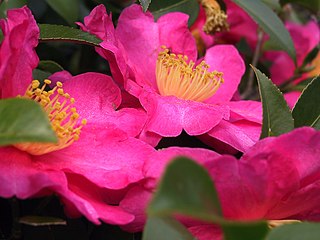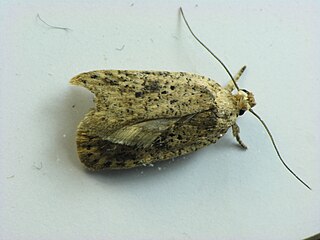
Camellia is a genus of flowering plants in the family Theaceae. They are found in eastern and southern Asia, from the Himalayas east to Japan and Indonesia. There are 100–300 described species, with some controversy over the exact number. There are also around 3,000 hybrids. The genus was named by Linnaeus after the Jesuit botanist Georg Joseph Kamel, who worked in the Philippines and described a species of camellia.

Camellia japonica, known as common camellia, or Japanese camellia, is a species of flowering plant in the family Theaceae. There are thousands of cultivars of C. japonica in cultivation, with many colors and forms of flowers. In the U.S. it is sometimes called japonica. In the wild, it is found in mainland China, Taiwan, southern Korea and southwestern Japan. It grows in forests, at altitudes of around 300–1,100 metres (980–3,600 ft). Camellias are famous throughout East Asia; they are known as tsaa4 faa1 in Cantonese, cháhuā (茶花) in Mandarin Chinese, tsubaki (椿) in Japanese, dongbaek-kkot (동백꽃) in Korean, and as hoa trà or hoa chè in Vietnamese.
Ulmus pseudopropinquaWang & Li, occasionally known in the United States as the Harbin spring elm, is a small deciduous tree found only in Heilongjiang, the northeasternmost province in China. The tree has not been studied comprehensively, and it has been speculated it may be a natural hybrid of Ulmus davidiana var. japonica and Ulmus macrocarpa.

Agonopterix ocellana is a species of moth of the family Depressariidae. It is found in Europe and was first described by Johan Christian Fabricius in 1775

Japonica rice, sometimes called sinica rice, is one of the two major domestic types of Asian rice varieties. Japonica rice is extensively cultivated and consumed in East Asia, whereas in most other regions indica rice is the dominant type of rice. Japonica rice originated from Central China, where it was first domesticated along the Yangtze River basin approximately 9,500 to 6,000 years ago.

Agonopterix is a moth genus of the superfamily Gelechioidea. It is placed in the family Depressariidae, which was often – particularly in older treatments – considered a subfamily of the Oecophoridae or included in the Elachistidae.

Agonopterix purpurea is a moth of the family Depressariidae. It is found in most of Europe.

Agonopterix senicionella is a moth in the family Depressariidae. It was described by August Busck in 1902. It is found in North America, where it has been recorded from Kentucky, Michigan, Ohio, Virginia and West Virginia.
Agonopterix walsinghamella, or Walsingham's agonopterix moth, is a moth in the family Depressariidae. It was described by August Busck in 1902. It is found in North America, where it has been recorded from the north-eastern United States and Canada.
Agonopterix curvilineella, the curved-line agonopterix moth, is a moth in the family Depressariidae. It was described by William Beutenmüller in 1889. It is found in North America, where it has been recorded from Illinois, Indiana, Kentucky, Maine, Maryland, Massachusetts, Michigan, Minnesota, Mississippi, New Brunswick, New York, Ohio, Ontario, Quebec, Tennessee, West Virginia and Wisconsin.
Agonopterix dammersi is a moth in the family Depressariidae. It was described by Clarke in 1947. It is found in North America, where it has been recorded from southern Arizona and California.
Agonopterix hesphoea is a moth in the family Depressariidae. It was described by Ronald W. Hodges in 1975. It is found in North America, where it has been recorded from Texas.
Agonopterix issikii is a moth in the family Depressariidae. It was described by Clarke in 1962. It is found in Japan.
Agonopterix latipalpella is a moth in the family Depressariidae. It was described by William Barnes and August Busck in 1920. It is found in North America, where it has been recorded from Texas.
Agonopterix melanarcha is a moth in the family Depressariidae. It was described by Edward Meyrick in 1913. It is found in South Africa.
Agonopterix pallidior is a moth in the family Depressariidae. It was described by Stringer in 1930. It is found in Japan and the Russian Far East.
Agonopterix septicella is a moth in the family Depressariidae. It was described by Snellen in 1884. It is found in south-eastern Siberia.
Agonopterix takamukui is a moth in the family Depressariidae. It was described by Shōnen Matsumura in 1931. It is found in Japan (Kyushu) and the Russian Far East.
(S)-corytuberine synthase is a cytochrome P450 enzyme purified from the plant Coptis japonica, with EC number EC 1.14.19.51 and CYP Symbol CYP80G2, and catalyses an intramolecular C-C phenol coupling of (S)-reticuline in magnoflorine biosynthesis.






